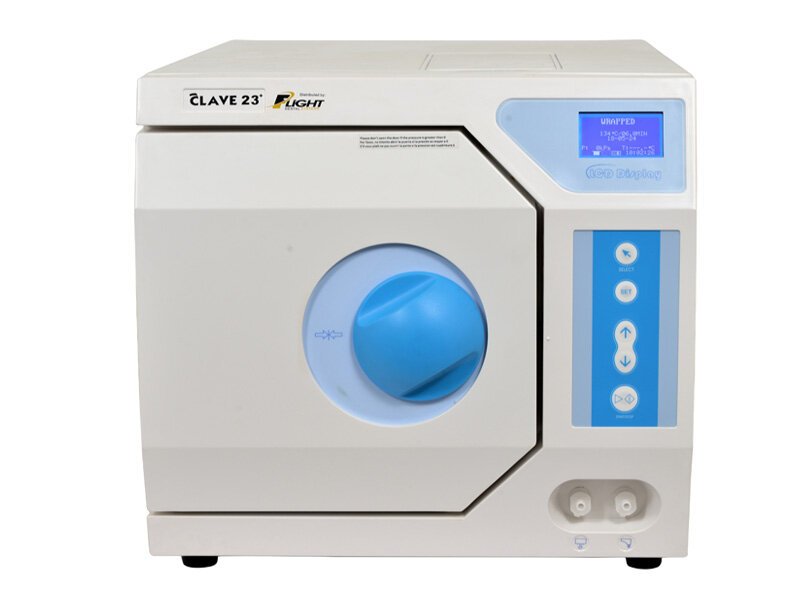Selecting and Using a Veterinary Autoclave
Autoclaves for veterinary use are a key piece of equipment for sterilizing surgical (and dental) tools and packs, gowns, drapes, and items for wound care and other procedures such as Penrose drain.
Outside of vet med, autoclaves are also used at human hospitals, tattoo parlors, research facilities, and various other businesses that require sterile equipment.
Although different models of autoclaves serve a similar purpose, there is variation when it comes to which type of autoclave best meets the needs of a specific veterinary hospital. Here are some things to consider when purchasing or upgrading…
Veterinary Autoclave Automation: Is Manual or Automatic Better?
Autoclave technology—particularly, automatic versus manual operation—is a hotly debated topic. There’s no right or wrong answer, but rather individual preference based on knowing the pros and cons of each.
Supporters of manual-function autoclaves claim they break down less often. Thus, they don’t incur the inconvenience and expense of frequent repairs. And despite the technology being older, many vets can easily have valves and seals replaced or repaired.
The downside is that manual machines require more time and attention from staff. Team members must do things by hand rather than using a “set it and forget it” button. This takes time away from patient-care tasks. It can even lead to a safety concern in some cases if the machine is ignored while running.
Many practices love automatic autoclaves for their simplicity and ease of use. Team members can just select a setting, then leave the machine to complete the cycle without any intervention. This saves time and prevents user errors, especially when the practice is busy.
However, the high temperatures and moisture of the autoclave can be detrimental to the electronic components of automatic machines. And electronic parts might be more difficult to replace or repair when compared with basic components like seals. Thus, some veterinarians have complained that this newer technology breaks down more often.
Factors When Selecting an Autoclave for Veterinary Use
In addition to the automatic versus manual question, here are some considerations…
New or Used. Some veterinarians and practice managers prefer to buy new equipment that comes with a longer warranty, and perhaps even a maintenance and repair plan. A good quality used or refurbished model might make sense for some hospitals, though. Veterinary autoclaves can last a long time (some have been known to keep going 20+ years!), so both new and used can potentially be a great investment.
Specific Functions and Guidelines. See which cycles and functions can be performed on your machine—such as wrapped and unwrapped packs, gowns and fabrics, liquids, rubber/plastic, etc.—and how long each will take. Make sure it covers everything you might possibly need to autoclave and works fast enough for your needs.
Autoclave Size. Practice pace and number of surgeries per day or per week generally determine the size of autoclave that is needed. To ensure you’re comparing apples to apples when price shopping, and that you find something specific to your clinic’s needs, look at the machine’s…
Chamber size (volume and dimensions).
Tray size and capacity (some have multiple rows of trays to maximize capacity).
How many standard packs or cassettes can be sterilized at a time?
How much space does it take up on the countertop?
Machine Maintenance and Repairs. Planning ahead can help ensure that ongoing autoclave operation is as smooth as possible. Prior to your purchase, ask questions about how to maintain the machine. For example, how often should it be cleaned in-hospital, and is there a special cleaning solution required?
Also, think about who will be repairing it and how long it takes for repairs/receiving replacement parts.
Is there a warranty in place? What about a 24/7 technical helpline? How much do repairs typically cost, and will you be given a loaner machine in the meantime?
Some vets choose to get in touch with a local repair person who’s not associated with the autoclave’s manufacturer or distributor. Developing a relationship with a local human hospital could be a way to get in touch with a local repair person.
Confirming Sterilization. It’s important to ensure your machine is effectively sterilizing your tools, even if it appears to be running smoothly. Always check your state’s minimum guidelines. Here are some common ways to monitor your machine’s effectiveness…
Indicator tape is the first line, with a color change to indicate the machine got hot. However, it’s not necessarily an accurate indicator of sterilization.
Indicator strips are also crucial, as they are a more accurate indicator of sterilization especially inside of a pack.
More and more veterinary practices are also routinely testing with biological indicators, confirming that the machine could effectively kill certain microorganisms.
Where to Find a Veterinary Autoclave Supplier or Get Recommendations
Checking colleagues’ recommendations is a great way to get helpful information and narrow down your choices. Talk face-to-face, look at forums on VIN, or check online reviews.
Also, check with your local distributors and sales reps to see what’s available. If they’ve sold autoclaves to local practices, ask for a referral to see how other practices like their equipment.
The decision will probably be a balance of cost, user-friendliness, maintenance considerations, functions/settings, size, and reviews from colleagues. These factors can help ensure your practice gets the best value to help facilitate daily practice flow, maximize patient care, and minimize headaches.
Written by: Dr. Tammy Powell, DVM




